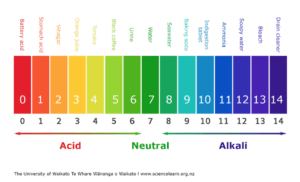Types, Properties And Composition of Soil SS1 Agricultural Science Lesson Note
Download Lesson NoteTopic: Types, Properties And Composition of Soil
Process Of Soil Formation (Weathering)
Weathering is defined as the disintegration or breakdown of rocks into tiny particles called soil
The processes of soil formation include:
- Physical process
- Chemical process
- Biological process
Physical Process: The agents of physical weathering are temperature, ice, wind, water and pressure
- Temperature: The alternating heating and cooling of rocks produce pressure within the rock which makes them break into smaller pieces
- Wind: Solid materials carried by soil surfaces
- Ice: The conversion of water inside the cracks of rocks into Ice results in an increase in volume. This results in more pressure on the rocks which eventually break into smaller pieces.
- Water: Running water carries some fragments of rocks in the river bed, thus breaking off small pieces of rocks.
Chemical Process: Agents of chemical weathering include, solution, carbonation, hydration, hydrolysis and oxidation.
a. Hydration: It occurs when water combines with or binds to some minerals e.g.
i) Calcium Sulfate changes to gypsum
CaSO4 + 2H20 > CaSO4.H2O
ii) Red Haematite changes to hydrated yellow Haematite or
Limonite
Fe203 + 3H20 = Fe203.H20
iii) CuSO4 + 5H20 = CuS04.5H 20
b. Carbonation: The carbon dioxide released to the atmosphere combines with acid. This weak acid reacts with rocks to form soil
c. Oxidation/Reduction: When minerals containing iron, manganese and sulfur are exposed to air and water, the famous iron is oxidized to the ferric state. eg
i. 4FOCO3+02
ii. 2FeO3+4C02
iii. Bron II Carbonate
iv. Iron Oxide
d. Solution: reaction of water with soluble particles/minerals present in the rock and eventually displacing them given the slope of the soil
e. Hydrolysis: involves the breaking down of chemical bonds in rock. minerals by water.
CaSiO + 2H20 = H₂SO + Ca(OH)2
Biological Process: This involves the activities of plants and animals in the breaking down of rocks to form soil. It can happen in the following ways.
i. The root of plants penetrates the rocks to form soil.
ii. Earthworms and termites burrow into the rocks and break off fragments.
iii. Activities of man during soil till causes the rock break down to form.
Some Properties Of The Soil
Soil Structure: This refers to the different particles of the soil that are packed or arranged. Good Soil structure will promote a good yield of crops. Soil Structure can be preserved in the following ways:
i. Planting of cover crops
ii. Application of manure
iii. Avoidance of overgrazing
iv. Mulching
v. Avoidance of clean clearing
The types of soil structures are:
i. Single grained structure
ii. Crumb Structure
iii. Plate-like structure
iv. Spheroidal structure
v. Prismatic structure
vi. Block-like structure
Importance Of Soil Structure
- It determines how fertile the soil
- A good soil structure supports aeration.
- It also prevents erosion and waterlogging
- A good soil structure promotes the activities of soil microbes.
- A good soil structure supports the growth of crops.
- Soil Texture: This is the relative proportion of various particles of the soil. It also refers to the degree of fineness or coarseness of the various soil particles. The particles which. make up a soil sample, gravel, sand, silt and clay are usually referred to as primary particles of the soil.
The name and sizes of the various soil particles are shown in the table below,
| S/N | Name of Particle | Diameter |
| 1 | Clay | Below 0.002mm |
| 2 | Silt | 0.002 – 0.02mm |
| 3 | Fine sand | 0.02 – 0.2mm |
| 4 | Coarse sand | 0.2 – 2.0mm |
| 5 | Gravel | Above 2mm |
Method Of Soil Texture Determination
i. By feeling
ii. By mechanical analysis through sieving
iii. By sedimentation
iv. By molding
IMPORTANCE OF SOIL TEXTURE
i. It is useful in the evaluation of the ability of soil to supply mineral nutrients
ii. It supports some micro organisms essential for crop growth
iii. It determines the type of crop to grow on the land.
iv. It enables the farmer to know the type of soil on his farm.
v. It determines the movement of air and water in the soil
- Soil Temperature: This refers to the hotness or coldness within the soil
Importance Of Soil Temperature To Crop Growth
i. It determines the rate of formation and decomposition of organic matter.
ii. High temperature will impede the activities of microorganisms.
iii. Optimum temperature promoted seed germination.
iv. It determines the population of soil microbes.
v. It determines the maturity or ripening of fruits.
- Soil pH: This is the measure of the degree of acidity or alkalinity of the soil. It can also be defined as the measure of the concentration of hydrogen ions (H+) in the soil. A PH scale used to determine soil acidity as shown below:

Causes Of Soil Acidity
i. Leaching
ii. Use of acid fertilizers
iii. Presence of acid parent materials
iv. Nutrient uptake by plants
v. Presence of sulfur in the soil
Removal Of Soil Acidity
Soil acidity can be removed by the application of liming materials which are rich in calcium. Examples of liming materials are:
- Slaked lime Ca(OH)2
- Quick lime Cao
- Calcium bicarbonate Ca(HCO3)2
- Wood ash
- Limestone CACO3
- Dolomite or Calcite
- Basic slay
- Gypsum
Soil Profile
A soil profile is defined as the vertical section of the soil showing a series of horizontal layers of different types of soil. The horizontal layers are called HORIZONS
Horizons Of Soil Profile
- The A-Horizon: It is also called the topsoil, it is rich in organic materials; most soil organisms reside here
- The B-Horizon: It is rich in minerals which are carried or leached down by percolating water
- Horizon C. It represents the type of material from which topsoil and subsoil are derived.
- The D-Horizon: It is called the bedrock
Experiments On Soil
- Sedimentation experiment.
- Experiment to determine the moisture content of the soil.
- Experiment to determine the porosity/water holding capacity of the soil.
- Experiment to determine the capillarity of the soil
- Experiment to demonstrate the preservation of microorganisms in the soil.
- Experiment to determine the percentage of organic matter in a soil sample.
ASSIGNMENT
- What is soil?
- List 5 factors of soil formation
- What is weathering?
- Explain the processes of physical weathering.
- Define
(1) Soil acidity
(ii) Soil structure
(ii) Soil texture






















